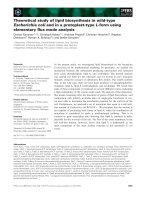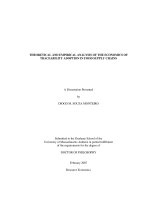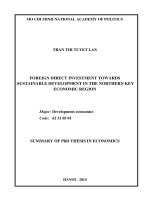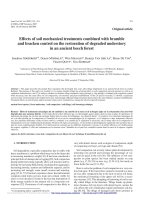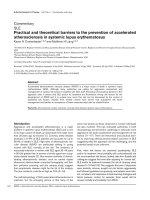late neoclassical economics restoration of theoretical humanism in contemporary mainstream economics
Bạn đang xem bản rút gọn của tài liệu. Xem và tải ngay bản đầy đủ của tài liệu tại đây (1.2 MB, 284 trang )
LATE NEOCLASSICAL ECONOMICS: RESTORATION OF
THEORETICAL HUMANISM IN CONTEMPORARY MAINSTREAM
ECONOMICS
A Dissertation Presented
by
YAHYA METE MADRA
Submitted to the Graduate School of the
University of Massachusetts Amherst in partial fulfillment
for the degree of
DOCTOR OF PHILOSOPHY
September 2007
Economics
UMI Number: 3289200
3289200
2008
Copyright 2007 by
Madra, Yahya Mete
UMI Microform
Copyright
All rights reserved. This microform edition is protected against
unauthorized copying under Title 17, United States Code.
ProQuest Information and Learning Company
300 North Zeeb Road
P.O. Box 1346
Ann Arbor, MI 48106-1346
All rights reserved.
by ProQuest Information and Learning Company.
© Copyright by Yahya M. Madra 2007
All Rights Reserved
LATE NEOCLASSICAL ECONOMICS: RESTORATION OF
THEORETICAL HUMANISM IN CONTEMPORARY MAINSTREAM
ECONOMICS
A Dissertation Presented
by
YAHYA METE MADRA
Approved as to style and content by:
__________________________________________________
Richard D. Wolff, Chair
__________________________________________________
Stephen A. Resnick, Member
__________________________________________________
Donald W. Katzner, Member
__________________________________________________
Julie Graham, Member
_____________________________________________
Diane Flaherty, Deparment Chair
Department of Economics
DEDICATION
To E.E., K.K., and R.B.Z.
v
ACKNOWLEDGEMENTS
It is practically impossible to acknowledge everyone who helped me in writing this
dissertation. While a dissertation is ultimately written in solitude, it can only be
possible with the support and the help of the author’s community. And since what I
consider to be my community is not a finite set, it is impossible for me to name all of
my fellow travellers who helped me in one way or another to complete this
dissertation. Nevertheless, there are those who are impossible not to acknowledge. I
apologize in advance from those who I will inevitably fail to recognize in these few
paragraphs.
I would like to begin by thanking the members of my dissertation committee. This
dissertation took its final shape thanks to Rick Wolff, who always asked me to fully
articulate the political implications of my work, to Steve Resnick, who always
demanded analytical rigour and conceptual accuracy, and to Don Katzner, who
kindly convinced me to appreciate the subtleties of the Walrasian vision.
Nevertheless, it would be impossible for me to keep on going without Julie Graham’s
intellectual generosity, theoretical acuteness, and affective support throughout the
entire process of the writing of this dissertation.
However, the dissertation owes a lot to my ongoing conversations with my two
mentors. Fikret Adaman, who introduced me to the socialist calculation debate and
therefore to many of the themes that I cover in my dissertation during my
undergraduate studies at Boğaziçi University, has always been there for me both as an
interlocutor and a friend. Jack Amariglio, whose writings convinced me that it is not
vi
only possible but necessary to use critical and poststructuralist theory in
understanding and interpreting economic theory, has been a constant presence
throughout my doctoral studies. In fact, I have finalized my dissertation in the
comfort of his and Christina’s home (my home in the States) during the winter break
of 2007. Without him, this dissertation would never finish.
Then, there are my friends. Ceren Özselçuk is my comrade and collaboratrice and
without the essays that I wrote with her through the years, I could not have sustained
my intellectual desire. Kenan Erçel, my brother, who is always on the other end of
the phone line, patiently listening to me, going along with my not-so-sound
speculations, have read my dissertation numerous times. Over the years, I have
excessively abused his weakness for editing. When I came to the US, it was Phil
Kozel with his VW Beetle who prevented me from running back home to İstanbul. I
began writing this dissertation with him (and Erik Olsen) during our weekly
dissertation support group meetings. He also read numerous drafts of this
dissertation, commenting on, and correcting the text with boundless generosity.
Stephen Healy, my one and only buddy, also read various drafts of this dissertation,
commenting on, and editing it. While living with him and Rose Heyer on 1 Graves
Ave., not only I had the intellectually most satisfying dinner conversations of my life,
but also together we threw the best Halloween parties in Northampton. I wrote a
bulk of this dissertation, in the summer of 2004, in Northampton, while sharing an
apartment with Maliha Safri. She also listened to my not-so-organized theoretical
innovations, read, commented, and corrected fairly and painfully rough drafts and
became a “soothing” presence in my life. That summer I was able to float by Joe
vii
Rebello many of the ideas that eventually found their way into the dissertation. He
was the perfect interlocutor: He was not only versed in poststructuralist theory but
also in late neoclassical economics. While I was teaching at Skidmore College, I met
Mehmet Odekon and Mary Crone Odekon. Without their friendship, hospitality,
and support, I could not have written this dissertation. And finally, I finished a first
complete draft of my dissertation in the loving presence of Ryvka Bar Zohar. The
communal home that we formed together in, of all places, Saratoga Springs during
2006-2007, provided all the necessary conditions of existence for me to write my
dissertation. I am grateful to her.
And my family. My grandmother Kamuran Kefeli, my father Teoman Madra, my
mother Beral Madra, and my sister Tulya Madra unwaveringly supported me
throughout my doctoral studies both emotionally and materially. I am grateful for
their patience.
viii
ABSTRACT
LATE NEOCLASSICAL ECONOMICS: RESTORATION OF THEORETICAL
HUMANISM IN CONTEMPORARY MAINSTREAM ECONOMICS
SEPTEMBER 2007
YAHYA METE MADRA, B.A., BOĞAZİÇİ UNIVERSITY
Ph. D., UNIVERSITY OF MASSACHUSETTS AMHERST
Directed by: Professor Richard D. Wolff
This dissertation investigates whether or not there is a clear break between
neoclassical economics (up to the 1970s) and the contemporary mainstream economic
approaches. The term “contemporary mainstream economic approaches” refers to a
seemingly heterogeneous set of approaches that include, among others, new
institutional economics, new information economics, social choice theory, behavioral
economics, evolutionary game theory, and experimental economics. In this
dissertation, in contrast to those who declare the “death of neoclassical economics”
and find a clear break (i.e., rupture, paradigm shift) between neoclassical economics
and the number of contemporary mainstream approaches listed above, I conclude
that these seemingly disparate approaches constitute a unified discursive formation
articulated around the theoretical problematic of theoretical humanism that they
share not only with one another but also with neoclassical economics. For this reason,
in order to underscore the philosophico-theoretical as well as the historico-
ix
genealogical continuity between neoclassical economics (up to the 1970s) and the
contemporary mainstream economic approaches, I shall refer to the latter as late
neoclassical economics.
In the late neoclassical context, neither the essentialist notions of human subject that
involve self-transparency, autonomy, rationality, and intentional agency nor the
ontologies of concordance, harmony, order and equilibrium are thoroughly
scrutinized. On the contrary, the late neoclassical context is characterized by a
concerted and multipronged effort to extend the scope of application of these notions
and ontologies either by way of broadening and enriching their meanings or by way
of introducing newer concepts that formulate the problem in slightly different ways
(e.g., static versus dynamic, general versus partial, price-adjustment versus market-
adjustment, cooperative versus non-cooperative) that would not necessarily address,
but essentially sidestep, the problems that trouble the earlier formulations. In fact, in
this sense, the contemporary mainstream economics is nothing but the shape that
neoclassical economics has taken as a mature and developed theoretical tradition.
x
CONTENTS
Page
ACKNOWLEDGEMENTS v
ABSTRACT viii
LIST OF TABLES xiv
LIST OF FIGURES xv
CHAPTER
1. INTRODUCTION 1
1. Introduction 1
1. 1. Making sense of the heterogeneity of late neoclassical economics 6
1. 2. From neoclassical to late neoclassical economics 17
1. 3. Towards a Marxist critique of theoretical humanism 30
1. 3. 1. The concepts of human subject and social reconciliation in theoretical
humanism 31
1. 3. 2. A Marxist critique of theoretical humanism 37
1. 3. 3. The constitutive theoretical problematic of neoclassical
humanism 47
1. 4. The outline of the dissertation 51
2. NEOCLASSICAL ECONOMICS: UNDER THE SHADOW OF
STRUCTURALISM 55
2. Introduction 55
2. 1. Early variations on the neoclassical problematic 58
2. 1. 1. Early neoclassicism: Walrasian and Marshallian 59
2. 1. 2. The ordinalist turn in neoclassical economics 64
2. 1. 2. 1. The empiricism of the revealed-preference approach 66
2. 1. 2. 2. The rationalism of preference orderings 69
2. 1. 2. 3. The pragmatism of the Chicago School 76
2. 1. 3. Conclusion 78
xi
2. 2. Theoretical humanism in crisis: The case of Walrasian economics in the
post-war period 81
2. 2. 1. The Arrow-Debreu model: Formalism without apologies 81
2. 2. 2. Two “structuralist moments” of the Arrow-Debreu model 86
2. 3. Theoretical humanism in the evolutionary mode: The case of Chicago
School in the post-war period 94
2. 3. 1. Selectionist arguments: Anthropomorphizing the evolution 96
2. 3. 2. Panglossian evolutionarism as the economic ideology of
neoliberalism 102
2. 4. Conclusion 106
3. LATE NEOCLASSICAL ECONOMICS 108
3. Introduction 108
3. 1. Three theses on late neoclassical economics 109
3. 2. Unity and dispersion in late neoclassical economics 112
3. 3. The so-called “break” thesis: The specter of Walrasian economics 120
3. 4. Conclusion 131
4. MARKET FAILURES AND ECONOMIC INSTITUTIONS IN LATE
NEOCLASSICAL ECONOMICS 136
4. Introduction 136
4. 1. The exchange perspective in the history of economics 138
4. 2. The sphere of exchange: Creating room for institutions 144
4. 2. 1. Two paths to market failures: Transaction costs and information
failures 145
4. 2. 1. 1. The new institutionalist concept of market failures:
transaction costs 145
4. 2. 1. 2. The post-Walrasian (new information economics) concept of
market failures: asymmetric information 147
4. 2. 2. Two ways to address market failures: More markets or institutional
design? 149
4. 3. The sphere of production: Opening the black box? 155
4. 3. 1. Two ways to open the black box: The Coasean and the post-
Walrasian traditions 156
xii
4. 3. 1. 1. The new institutional theories of the firm 157
4. 3. 1. 2. The post-Walrasian (new information) theories of the
firm 159
4. 3. 2. Sameness and difference in the late neoclassical theories of the
firm 160
4. 4. Conclusion 167
5. THE CONCEPT OF THE HUMAN SUBJECT IN LATE NEOCLASSICAL
ECONOMICS: MOTIVATİONAL DIVERSITY AND BOUNDED
RATIONALITY 170
5. Introduction 170
5. 1. Aspects of economic rationality: Preferences, information, competence 173
5. 2. Questions of motivational diversity in late neoclassical economics 180
5. 2. 1. Is there a motivational diversity? (Opportunism, altruism,
reciprocity) 183
5. 2. 2. How to theorize the origins of the motivational diversity? 187
5. 2. 2. 1. The “structuralist” response of the evolutionary game
theory 188
5. 2. 2. 2. The “individualist” response of the social choice theory 190
5. 3. Questions of cognitive competence in late neoclassical economics 194
5. 3. 1. The infinite regress of unbounded (substantive) rationality 197
5. 3. 2. Theoretical humanist presuppositions of cognitive economics 199
5. 4. Conclusion 203
6. EQUILIBRIUM, EFFICIENCY, AND INSTITUTIONS IN LATE
NEOCLASSICAL ECONOMICS: HUMANISM IN A GAME THEORETIC
MODE 205
6. Introduction 205
6. 1. Concepts of equilibrium in the neoclassical tradition 207
6. 2. From general equilibrium to the Nash equilibrium 215
6. 2. 1. The underlying assumptions of the Nash equilibrium concept 216
6. 2. 2. The humanism of the Nash equilibrium concept and the role of
institutions 219
6. 3. From the Nash equilibrium to evolutionary stability 225
6. 3. 1. Evolutionary game theory and the concept of “spontaneous
xiii
order” 225
6. 3. 2. Theoretical humanist presuppositions of evolutionary game
theory 230
6. 4. Conclusion: Neoclassical problematic in the game theoretic mode 236
7. CONCLUSION: TOWARD A MARXIST CRITIQUE OF LATE
NEOCLASSICAL HUMANISM 240
BIBLIOGRAPHY 248
xiv
LIST OF TABLES
Table Page
1. The Invisible Hand Game 215
2. The Assurance Game 220
3. The Prisoners’ Dilemma Game 222
4. The Hawk and Dove Game 226
5. The Disorder Game 236
xv
LIST OF FIGURES
Table Page
1. A Taxonomic Outline of Chapter 6 217
1
CHAPTER 1
INTRODUCTION
1. Introduction
This dissertation investigates whether or not there is a clear break between
neoclassical economics (up to the 1970s) and the contemporary mainstream economic
approaches. The term “contemporary mainstream economic approaches” refers to a
seemingly heterogeneous set of approaches that include, among others, new
institutional economics, new information economics, social choice theory, behavioral
economics, evolutionary game theory, and experimental economics.
1
In this
dissertation, in contrast to those who declare the “death of neoclassical economics”
(Colander, 2000) and find a clear break (i.e., rupture, paradigm shift) between
neoclassical economics and the number of contemporary mainstream approaches
listed above, I conclude that these seemingly disparate approaches constitute a unified
discursive formation articulated around a theoretical problematic that they share not
only with one another but also with neoclassical economics. For this reason, in order
to underscore the philosophico-theoretical as well as the historico-genealogical
continuity between neoclassical economics (up to the 1970s) and the contemporary
1
For recent surveys, see (Bowles and Gintis, 2000; Colander, 2000; Mirowski, 2002;
Colander, Holt and Rosser, 2004; Davis, 2006).
2
mainstream economic approaches, I shall refer to the latter as late neoclassical
economics.
2
There are two presuppositions of the neoclassical problematic that distinguishes the
tradition (and its derivatives and correlates) from the other traditions in economics.
On the one hand, all neoclassical approaches aim to specify the conditions of
existence of a harmonious and contradiction-free economic order (i.e., equilibrium).
On the other hand, in positing a teleological vision of an harmonious economic order,
each approach, explicitly or implicitly, refers back to a notion of human subject as a
autonomous, self-transparent, and rational self-consciousness, who knows (who is
conscious of) or can eventually know (can come to the consciousness of) what his/her
true needs (preferences) are and what is good for him/her (i.e., what improves his/her
welfare), who can translate these true and essentially transparent preferences into
his/her choices, and who recognizes himself/herself as (and recognized by others as)
an intentional and autonomous subject who is responsible for his/her choices (as it is
presupposed in the contract law). The pre-destined vision of an harmonious
economic order is one that should be chosen by, and hence that would best
accommodate the needs of, the self-transparent, unified, rational, autonomous, and
2
I have chosen this term over the two other contenders: post-neoclassical economics
and neo- (or new) neoclassical economics. The former was inappropriate for it gave
the impression of an accentuated break with neoclassical economics. (For instance,
Bowles and Gintis (1993) used the term post-Walrasian economics to signal their
break from Walrasian economics.) The latter, on the other hand, was simply too
clumsy and had the risk of being confused with new classical economics—a
macroeconomic school of thought. In contrast, the designator “late neoclassical
economics” connotes the idea of continuity rather clearly.
3
self-conscious human subjects.
3
In short, the constitutive theoretical problematic of
the neoclassical tradition is to address the various facets of the following question:
what are the conditions of existence of a harmonious and contradiction-free socio-
economic order (ranging from an efficient and stable state of equilibrium to a vision of
social order that would facilitate economic growth) that would best accommodate the
needs of human subjects as they are postulated in theory (according to the standard
neoclassical axioms of rationality)? Or, to put it as economically as possible: the
neoclassical tradition is structured around the theoretical problematic of reconciling
the individual and the aggregate (collective, social, market) rationality.
4
3
In his now well-known Jevons Memorial Lecture entitled “In Praise of Economic
Theory,” Frank Hahn specified the following as the essential features of neoclassical
economics (Hahn, 1985; cf. Lawson 1997: 87):
(1) an individualistic perspective, a requirement that explanations be couched
solely in terms of individuals;
(2) an acceptance of some rationality axiom; and
(3) a commitment to the study of equilibrium states.
All these features are captured in the working definition of the neoclassical
problematic provided here. I argue that, however, while the latter two remained
intact throughout the history of the neoclassical tradition and continues to remain
intact even today, the first feature (i.e., individualism), whether it is acknowledged by
neoclassical economists or not, has been repeatedly violated by “structuralist
moments” throughout the history of the tradition.
4
This formulation of the neoclassical theoretical problematic may be somewhat
unfamiliar to the reader. The formulation relies on Kenneth Arrow’s formulation of
the different types of social choice in his Social Choice and Individual Values (1963: 1-3):
“In a capitalist democracy there are essentially two methods by which social choices
can be made: voting, typically used to make ‘political’ decisions, and the market
mechanism, typically used to make ‘economic’ decision. […] The methods of voting
and the market are methods of amalgamating the tastes of many individuals in the
making of social choices. […] Can we find other methods of aggregating individual
tastes which imply rational behavior on the part of the community?” In other words,
like the voting mechanism, the market mechanism is also a method for reconciling the
individual and the collective (aggregate) rationality. More on this below in section 1.
3. 3.
4
These concerns belong to theoretical humanism, a decidedly post-Enlightenment
philosophical orientation which establishes a vision of social harmony premised upon
a notion of human subject who is centered, self-transparent, rational and
autonomous. Theoretical humanism, as a philosophical orientation, cuts across
numerous schools of thought within the discipline of economics, including even, for
instance, some skeins of Marxian economics (e.g., Analytical Marxism) as well as
other disciplines of social theory.
5
I further argue that the contemporary mainstream
economics is a series of responses to the loss of the disciplinary hegemony of the
general equilibrium theory in neoclassical microeconomics and the perceived
damaging implications of the related twentieth century developments and
controversies for the theoretical humanist project of the neoclassical tradition.
Therefore, I claim that there is no clear break that separates the contemporary
mainstream approaches from the earlier neoclassical approaches because the former
is nothing but a series of attempts at restoring, rehabilitating, and reconstituting the
theoretical humanist presuppositions of neoclassical economics.
6
As I will show in the following chapters, in the late neoclassical context, neither the
essentialist notions of human subject that involve self-transparency, autonomy,
rationality, and intentional agency nor the ontologies of concordance, harmony, order
5
For critiques of theoretical humanism in the Marxian tradition and in the discipline
of economics, see (Althusser, 1969; 1996; 2003; Hindess, 1977; Coward and Ellis,
1978; Callari, 1981; Resnick and Wolff, 1987; Amariglio, Resnick and Wolff, 1990;
Ruccio and Amariglio, 2003).
6
I intend to use the term “presuppositions” by distinguishing it from the
“assumptions” or “postulates” of a theoretical approach. The latter can be modified
depending on the requirements of a specific theoretical and applied context. In
contrast, the presuppositions of a theory are its entry points or points of departure.
Presuppositions, unlike axioms (which are explicitly acknowledged presuppositions),
can be unconscious and remain unacknowledged.
5
and equilibrium are thoroughly scrutinized. On the contrary, the late neoclassical
context is characterized by a concerted and multipronged effort to extend the scope of
application of these notions and ontologies either by way of broadening and enriching
their meanings or by way of introducing newer concepts that formulate the problem
in slightly different ways (e.g., static versus dynamic, general versus partial, price-
adjustment versus market-adjustment, cooperative versus non-cooperative) that would
not necessarily address, but essentially sidestep, the problems that trouble the earlier
formulations. In fact, in this sense, the contemporary mainstream economics is
nothing but the shape that neoclassical economics has taken as a mature and
developed theoretical tradition.
This introductory chapter will address three matters. First, it will motivate the project
and situate it in the context of contemporary methodological debates on the
“pluralism” of mainstream economics and the difference between the disciplinary
orthodoxy and heterodoxy. Second, it will provide a brief sketch of transition from
the post-WWII neoclassicism to the contemporary late neoclassical condition. A
detailed philosophical discussion of this historical trajectory of the neoclassical
tradition is the subject matter of the subsequent chapters. And third, it will introduce
and explore the various dimensions of theoretical humanism as a decidedly post-
Enlightenment yet non-secular philosophical movement across disciplines will develop
the contours of a secular Marxist critique of the essentialist notions of human subject,
the concept of autonomous choice, and the social ontologies of concordance and
harmony that underpin the theoretical humanist problematic.
6
1. 1. Making sense of the heterogeneity of late neoclassical
economics
Recently, heterodox economists, who are critical of and seek alternatives to the
mainstream economic theories and policies, are themselves being criticized for
misrepresenting the mainstream economics as a unified and monolithic discourse
(Garnett, 2005: 2). In the lexicon of the heterodox literature that “succumbs” to this
tendency, the term “mainstream economics” refers to those approaches that explain
all economic (and social) phenomena as states of equilibrium that should be
systematically “microfounded” in the rational choices and actions of utility
maximizing individual economic agents (i.e. homo economicus). Moreover, these
heterodox critics tend to argue that the mainstream economics amounts to nothing
more than an elaborate apologetics (usually with the theological connotations of the
word intended) for the existing state of affairs (i.e., the global hegemony of the
neoliberal ideology and the multinational capitalism).
It should come as no surprise then that those who find these mainstream approaches
to be substantially different from post-war neoclassicism and who is convinced by this
difference are the most vocal critics of this heterodox representation of the
contemporary mainstream approaches as nothing but neoclassical economics circa
1950.
7
According to these mainstream (and heterodox) critics of “heterodox
7
This is not to say that there are no heterodox economists who are critical of this
“heterodox” tendency to represent neoclassical economics as a monolithic discourse.
For instance, among others, Robert Garnett (2005), Edward Fullbrook (2001), John B.
Davis (2005f), and Esther Mirjam Sent (2001) have all noted their various misgivings
about this heterodox tendency for reducing mainstream economics to a monolithic
discourse. According to these scholars, this reductionist tendency emanates from a
widely held commitment among heterodox economists to a Kuhnian vision of science
as a contested field of social discourse and practice consisting of distinct and
incompatible scientific paradigms (Garnett, 2005: 6; see also Fullbrook, 2001).
7
reductionism,” the representation of the contemporary mainstream economics as a
cohesive and unified discourse and the claim that it is not much different from
neoclassical economics circa 1950s papers over the important differences among the
aforementioned new mainstream approaches and thereby prevents the heterodox
economists from recognizing and acknowledging the “emerging pluralism” in the
contemporary mainstream economic thinking.
Indeed, a new narrative regarding the emergence of a mainstream pluralism is swiftly
gaining currency in economics among the proponents of contemporary mainstream
approaches as well as those who write on the contemporary state of mainstream
economics. According to this narrative, by the 1970s, with the full development of
the Walras-Arrow-Debreu model, the results of Sonnenschein-Mantel-Debreu, and
the politically-charged controversies surrounding the auctioneer fiction, the
neoclassical project of formalizing the invisible hand theorem has fallen into a crisis
Garnett (2005) reminds us that this vision of “paradigm warfare” emerged in the mid
to late 1960s, during the height of the Cold War, in reaction to the mainstream
microeconomists such as Gérard Debreu, who, using the language of Bourbakist
mathematical structuralism, referred to the model of Walrasian equilibrium as “the
root structure from which all further work in economics would eventuate”
(Weintraub, 2002: 121). In response to this absolutist high modernism of the
mainstream, the heterodox economists of various stripes were forced to embrace the
vision of paradigm warfare, if only “to survive under difficult professional
circumstances” (Garnett, 2005: 6). According to the vision of paradigm warfare, the
task of heterodox economists was not only to articulate a rigorous critique of
mainstream economics but also to supplant the latter with a compelling, systematic,
complete and superior alternative framework (Garnett, 2005: 7). Nonetheless, even if
the representation of mainstream economics as a monolithic discourse was inevitable
during the hostile environment of the Cold War era, it has become, Garnett argues,
“largely anachronistic and self-defeating for heterodox economists today” (2005: 6). It
is anachronistic because it is factually incorrect. (Garnett seems to concur on this
account with the likes of Davis (2005; 2006), Colander (2000), Colander, Holt and
Rosser (2004), and others.) It is self-defeating because, it promotes an isolationist
“bunker mentality” (Garnett, 2005: 7), “encourages an all-or-nothing view of
intellectual change” (Garnett, 2005: 7), and “undercuts heterodox economists’
commitments to pluralism” (Garnett, 2005: 7).
8
(Davis, 2003: 82). In the aftermath of “the death of neoclassical economics”
(Colander, 2000), the mainstream economic thinking began to move away “from a
strict adherence to the holy trinity—rationality, selfishness, and equilibrium—to a
more eclectic position of purposeful behavior, enlightened self-interest and
sustainability” (Colander, Holt and Rosser, 2004: 485; emphasis added), and in fact, it
is claimed, the mid-century Walrasian neoclassicism was an unnecessary detour that
delayed the development of “analytical models of incomplete contracts and broader models
of human behavior” (Bowles and Gintis, 2000: 1429; emphasis added)—namely, the
development of the hallmark themes of what I call late neoclassical economics.
It is important to note, however, that those who find “pluralism” in the contemporary
mainstream do not only see a clear break between the contemporary mainstream and
the post-war neoclassicism, but also argue that it is inappropriate to brand the
contemporary mainstream as the new “orthodoxy” (as the “other” of the heterodox
economics). For, it is argued, there are a number of approaches within the
contemporary mainstream that are quite different from and critical of the neoclassical
orthodoxy (Colander, Holt and Rosser, 2004: 490-3). Nevertheless, curiously enough,
none of the self-identified heterodox economic approaches (e.g., old institutional
economics, Marxian economics, Post Keynesian economics, Sraffian economics,
feminist economics, Austrian economics) are cited among those that constitute this
“pluralist turn” in economics. For instance, David Colander (2000) when defining
“New Millennium Economics” mentions only three approaches: evolutionary game
theory, experimental economics, and complexity theory. In an expanded version,
John B. Davis (2006) lists game theory, experimental economics, behavioral
economics, evolutionary economics, and complexity theory (see also, Colander, Holt
9
and Rosser, 2004: 496). Samuel Bowles and Herbert Gintis (2000) identify Ronald
Coase, Friedrich von Hayek, Duncan Luce and Howard Riaffa, and Herbert Simon
as the predecessors of contemporary “multidisciplinary” economics that emerged as
the “younger generation of economists” realized that “the Walrasian economic model
should be taken with a grain of salt” (2000: 1431).
8
To recapitulate, going through a
quick checklist of what schools of thought are included and what schools are excluded
in these lists renders it clear that we are not dealing with a thorough-going
“pluralism” here (for a similar critique, see Davis, 2006; 2007f).
* * *
This dissertation aims to recast the terms of this debate between those who find
sameness across the past and the present of the mainstream economics and those who
find difference between the past and the present and within the present of the
mainstream economics. In contrast, I find both sameness and difference, both unity and
diversity within both neoclassical and late neoclassical economics. Moreover, I do
acknowledge that a lot has changed in the neoclassical tradition since the 1950s.
Nevertheless, I also conclude that these changes do not add up to a paradigm shift in,
or a radical break from, the tradition. I argue that both the neoclassicism of the post-
war period and the mainstream economics of today (i.e., late neoclassical economics)
are structured around the same theoretical humanist problematic. They may
formulate the theoretical problematic in different ways, using different concepts and
8
The proper names that Bowles and Gintis invoke stand in for, respectively, the new
institutional economics, the evolutionary game theory, the Nash refinements tradition
of game theory, and behavioural economics. Given their most recent work (Heinrich
et al., 2004; Gintis et al., 2005), one should probably add experimental economics to
their list.

